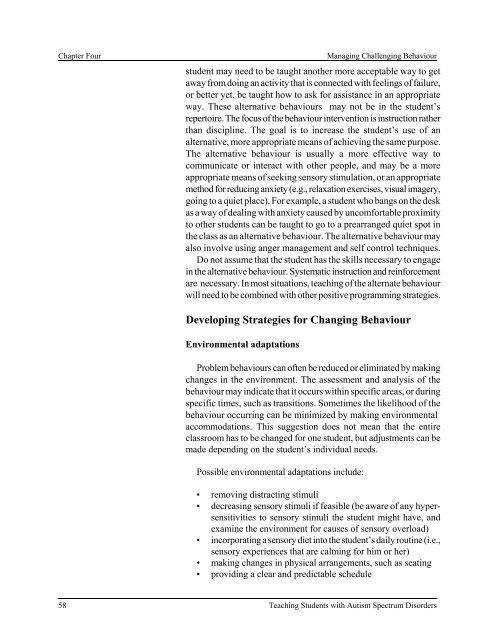Teaching Students with Autism Spectrum Disorders
Teaching Students with Autism Spectrum Disorders
Teaching Students with Autism Spectrum Disorders
Create successful ePaper yourself
Turn your PDF publications into a flip-book with our unique Google optimized e-Paper software.
Chapter Four Managing Challenging Behaviour<br />
student may need to be taught another more acceptable way to get<br />
away from doing an activity that is connected <strong>with</strong> feelings of failure,<br />
or better yet, be taught how to ask for assistance in an appropriate<br />
way. These alternative behaviours may not be in the student’s<br />
repertoire. The focus of the behaviour intervention is instruction rather<br />
than discipline. The goal is to increase the student’s use of an<br />
alternative, more appropriate means of achieving the same purpose.<br />
The alternative behaviour is usually a more effective way to<br />
communicate or interact <strong>with</strong> other people, and may be a more<br />
appropriate means of seeking sensory stimulation, or an appropriate<br />
method for reducing anxiety (e.g., relaxation exercises, visual imagery,<br />
going to a quiet place). For example, a student who bangs on the desk<br />
as a way of dealing <strong>with</strong> anxiety caused by uncomfortable proximity<br />
to other students can be taught to go to a prearranged quiet spot in<br />
the class as an alternative behaviour. The alternative behaviour may<br />
also involve using anger management and self control techniques.<br />
Do not assume that the student has the skills necessary to engage<br />
in the alternative behaviour. Systematic instruction and reinforcement<br />
are necessary. In most situations, teaching of the alternate behaviour<br />
will need to be combined <strong>with</strong> other positive programming strategies.<br />
Developing Strategies for Changing Behaviour<br />
Environmental adaptations<br />
Problem behaviours can often be reduced or eliminated by making<br />
changes in the environment. The assessment and analysis of the<br />
behaviour may indicate that it occurs <strong>with</strong>in specific areas, or during<br />
specific times, such as transitions. Sometimes the likelihood of the<br />
behaviour occurring can be minimized by making environmental<br />
accommodations. This suggestion does not mean that the entire<br />
classroom has to be changed for one student, but adjustments can be<br />
made depending on the student’s individual needs.<br />
Possible environmental adaptations include:<br />
• removing distracting stimuli<br />
• decreasing sensory stimuli if feasible (be aware of any hypersensitivities<br />
to sensory stimuli the student might have, and<br />
examine the environment for causes of sensory overload)<br />
• incorporating a sensory diet into the student’s daily routine (i.e.,<br />
sensory experiences that are calming for him or her)<br />
• making changes in physical arrangements, such as seating<br />
• providing a clear and predictable schedule<br />
58 <strong>Teaching</strong> <strong>Students</strong> <strong>with</strong> <strong>Autism</strong> <strong>Spectrum</strong> <strong>Disorders</strong>

















